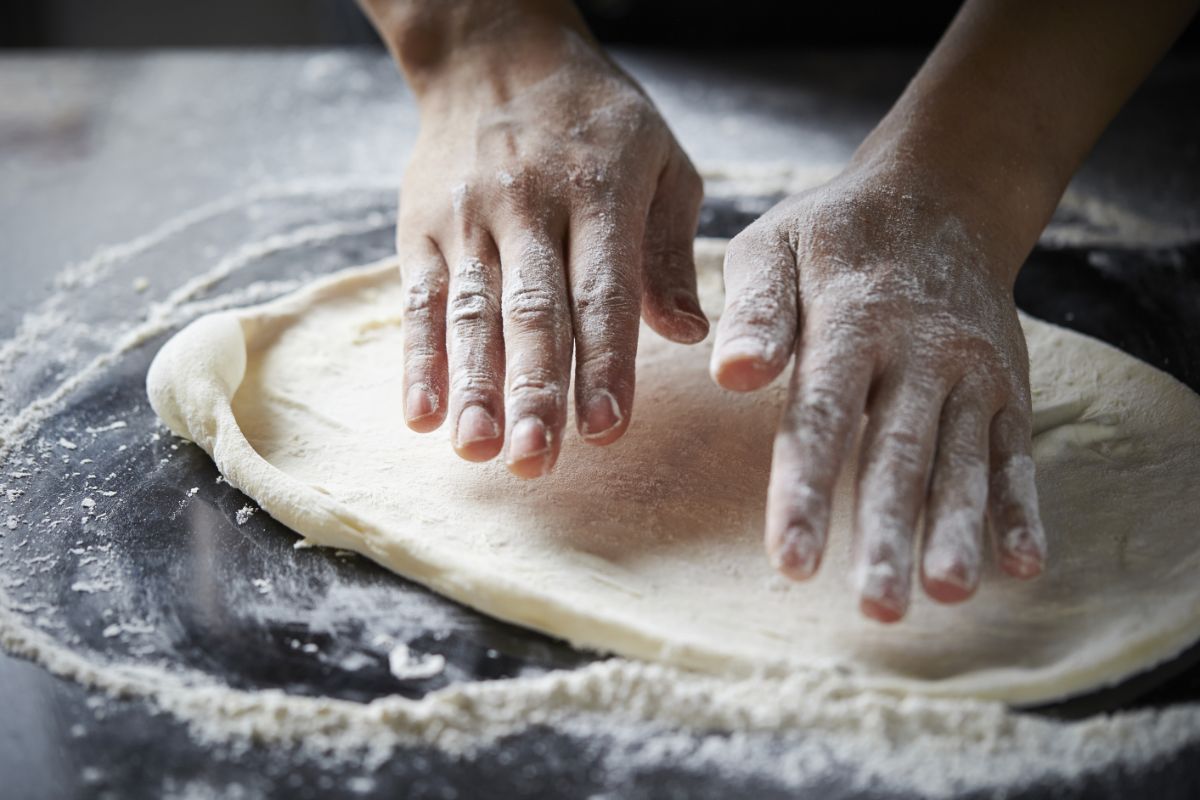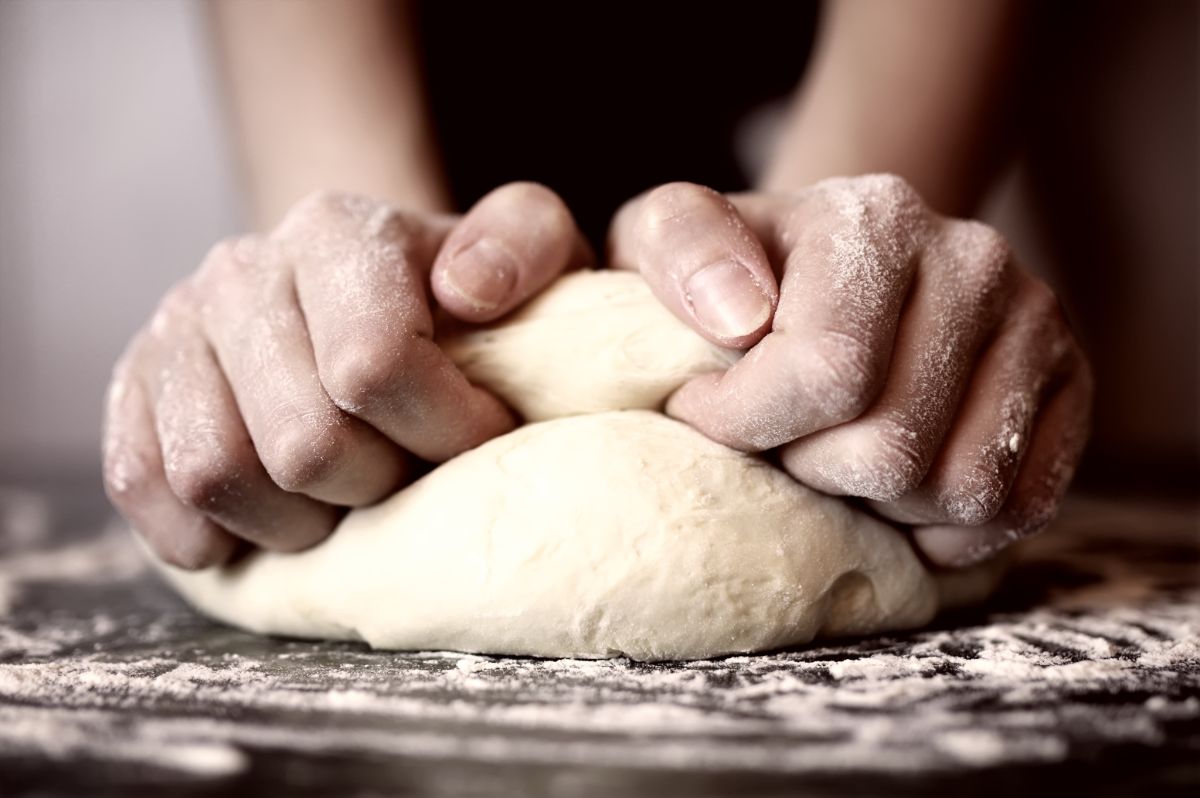Kneading pizza dough distributes ingredients, incorporates air, and helps to develop gluten. While hand kneading may seem like a gratifying process, a stand mixer can make the job easier. If you’re kneading by hand, it can get messy and it may be difficult to know when you’re done. A general rule of thumb is to knead for 10-12 minutes by hand or for about 8 minutes with a mixer.
How do you know when pizza dough is kneaded? Well, you can easily tell after the first few turns. But there are a couple of things you should look for. If you have a smooth dough, then it’s ready.

While there’re different methods of kneading, you should use the heel of your countertop to press the dough. Continue for a couple of minutes and you’ll have a soft dough.
Also, the dough should hold well between your hands – just like stretching a balloon before you blow it up. You should always look for a tacky texture. If there’re some sticky parts in the dough, continue kneading.
Secondly, you should test whether the dough holds its shape. Simply make a ball and drop it onto your work surface. You can also press the dough with your finger.
If an indentation remains, then the dough still needs more work. The same applies if the dough springs back to the original shape. Another way of checking if the dough is ready is to perform the windowpane test.
Tear off the dough between your fingers and observe what happens. If the dough tears, you should give it more time to develop gluten.
In case you’ve been kneading for about 12 minutes and your hands feel tired, the dough should be ready. As long as the dough passes the above tests, you should be confident with your work.
And after the first kneading is finished, you should store the dough in a dry place. If you’re not careful, you could end up with an under-kneaded or over-kneaded dough.
The science behind kneading pizza dough
The concept of kneading dates back thousands of years. When all ingredients are mixed, the proteins line up to form a chain of amino acids.
According to modern science, wheat flour contains two ingredients (glutenin and gliadin) which form gluten. Generally, gluten is a matrix that helps to trap gas released by yeast and leavening agents.
There are two methods of kneading – hand and mechanical. Hand kneading involves stretching and folding the dough repeatedly. The process takes about 10 minutes or until the dough gets a silky texture.
On the other hand, mechanical kneading involves the use of a food processor or stand mixture. If you’re using an automated mixture, you should not take more than 8 minutes.
Can you under-knead or over-knead pizza dough?

Yes. When you under-knead the bread, it will not hold its shape. As you try to work on the countertop, it keeps paddling on the surface. Worst of all, the gases produced by the yeast can escape.
At this point, you should shape the dough into a ball and allow it to rest for 15-20 minutes. Repeat the process a couple of times and shape it into a pizza.
If you’re not new to baking, you can tell if the pizza dough is over-kneaded. This happens when you use a food processor or stand mixture as the process happens more quickly.
If you’re using a mixture to make pizza dough, check every 2-3 minutes to see how it’s coming along. So, can you tell you’ve over-kneaded the dough? It tears off easily since the gluten is not elastic enough (it can also be too tight).
When you use your hands, it’s nearly impossible to over-knead the dough. In any case, you can tire yourself easily. If you’re not sure whether you’ve over-kneaded the dough or not, allow the dough to relax a little.
There’s no question whether stickier dough leads to a lighter pizza or not. For first-time bakers, higher water concentration can be a frustrating experience. The only surefire way to confirm pizza kneading is done is to ensure that it’s no longer sticking on the fingers.
How to make pizza dough from scratch
While making pizza dough is a straightforward process, you should prepare beforehand. Since most recipes call for the use of active dry yeast, you should activate it before adding to the dough.
For the recipes that call for fresh yeast, you should mix it with a small amount of flour. The next step is to mix the other dough ingredients. Pour both dry and wet ingredients into a bowl and mix with your hand.
After that, knead for about 10-12 minutes. This will allow the dough to develop gluten strands. In addition to that, the dough will attain the right texture.
Allow the dough to ferment for about 24 hours by placing it in the refrigerator. During this process, the yeast will feed on carbohydrates to produce carbon dioxide – the dough doubles in size.
Give it a few doubles to release the excess gases. The next step is to shape the dough and place it on a flat surface. Be sure to make a small indentation and then draw the edges towards the center. The dough should double before its ready to use.
Avoid adding too much flour during the kneading process as it can throw off the ratio of water and flour. What happens if you don’t knead pizza dough? The main purpose of kneading is to allow the dough to develop a gluten structure. If you ignore this process, your pizza dough will be hard.
If you’re a baking enthusiast, you could be asking, what’s the difference between pizza dough and ordinary bread dough? The only notable difference is how the dough is cooked.
If you’re not sure whether you’re under-kneading or over-kneading, you should try both sides of the spectrum. When making pizza dough, work at hip height to avoid neck, shoulder, and back pain. And once the dough is ready, you should test the gluten window.
Final words
Kneading helps pizza dough develop into a smooth, elastic ball. Those made with specialty flours require 5 minutes of kneading depending on the recipe.
If you knead the dough until it’s springy and soft, the pizza will have a chewy interior. Likewise, if the dough is not thoroughly kneaded, the pizza will be dense and flat.
And depending on your preference, you can knead by hand or with a stand mixer. The trick is to make gentle stretches on the dough. Whether you’re a beginner or a professional baker, you should learn how to prepare pizza dough that is just right.
